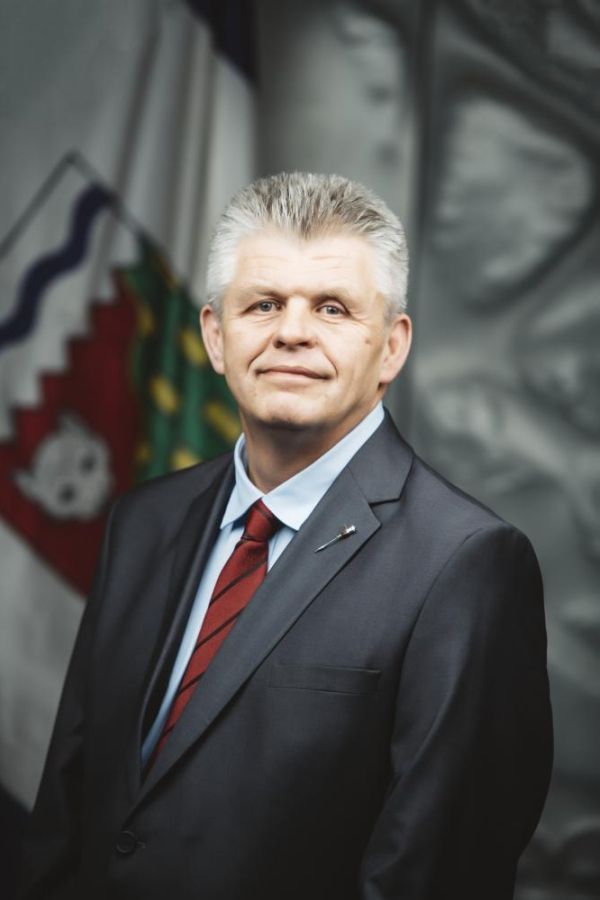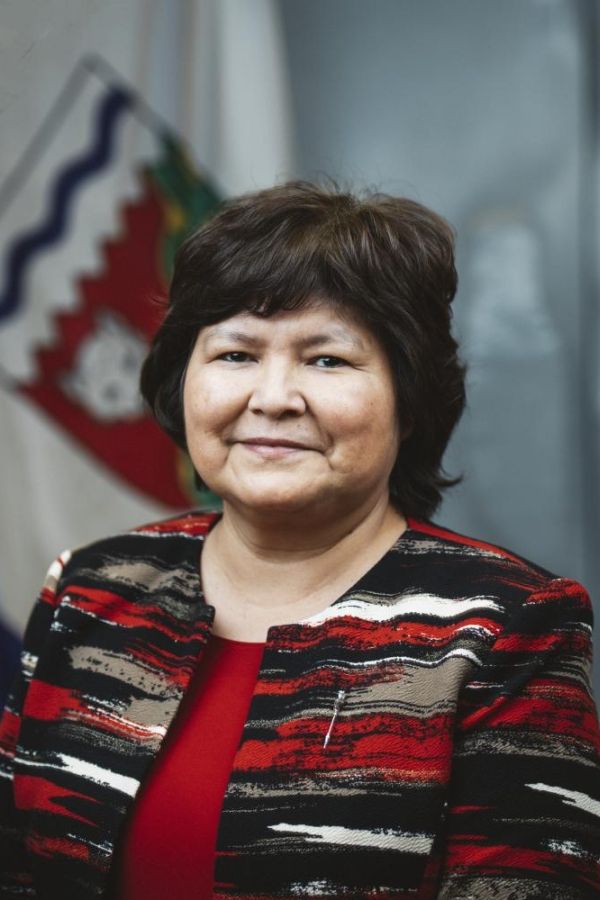
Thank you. So I can respect that answer. I just -- I guess I'd like to hear from the Minister of Environment and Climate Change that, in fact, yes, having -- even though there aren't any other options, vehicles, all of our infrastructure that emits greenhouse gases, does impact climate change. Thank you, Mr. Chair.
Thank you. I'm going to go to the Minister.

Thank you, Mr. Chair. Yes, I do agree with that statement. It certainly does have an impact. Thank you, Mr. Chair.
Thank you. I'll go back to the Member from Great Slave.

Thank you, Mr. Chair. Well, I will take away some further comments to the Minister. Nothing further at this time.
Thank you. I'm going to go to the Member Range Lake.

I'm curious now, Mr. Chair, so I'm going to ask. As the Minister is the Minister responsible for Climate Change and the government's climate change plan, and he's got officials there, is it possible to calculate the carbon emissions or carbon impact of one truck in the GNWT fleet? Thank you.
Thank you. I'm going to go to the Minister.

Thank you, Mr. Chair. I'll pass that to Dr. Kelly.
Thank you. I'm going to go to the deputy minister.
Thank you, Mr. Chair. We don't normally look at that level of granularity. I'd have to take that back. Thank you, Mr. Chair.
Thank you. I'm going to go to the Member from Range Lake.

Would that information -- sorry, thank you, Mr. Chair. Would that information be useful to our climate change planning to -- and implementation of our strategy and our goals to reduce emissions? Thank you.
Thank you. I'm going to go to the Minister.

Thank you, Mr. Chair. That level of detail would be really hard to calculate. We take a much broader approach to how we do the calculations on the greenhouse gas emissions. Thank you, Mr. Chair.
Thank you. I'm going to go to the Member from Range Lake.

Thank you, Mr. Chair. So the GNWT does calculate its fleet -- like, its combined fleet in terms of emissions; is that correct?
Thank you. To the Minister.

Thank you, Mr. Chair. I am not 100 percent sure we do it to that level in-house, I'm certainly happy to get that information for the Member. Thank you, Mr. Chair.
Thank you. I'm going to go to the Member from Range Lake.

Thank you, Mr. Chair. And I think that's a much more useful -- useful metric because then we can -- we can factor it into those larger emissions pictures as we look for -- you know, actively seek for replacement technologies. I think it's very difficult when you're dealing with certain types of equipment, as the Minister said. So I just wanted to get a sense of what we actually look at and what's possible and what's useful fundamentally when we're trying to deliver on the climate change strategy and meet our net-zero goals, our 2050 net-zero goals. And that's probably a broader conversation that he will have to have with the Minister of Infrastructure. Nothing further, thank you.
Thank you. Any further general comments from Members? Okay, thank you. Seeing none, continuing on.
Department of Environment and Climate Change, regional operations, infrastructure investments, $430,000. Does committee agree?
Agreed.
Thank you. Next, we have wildlife and forest management on page 29 with information items on page 30 to 32. Are there any questions? I'm going to go to the Member from Yellowknife North.

Thank you, Mr. Chair. So first I wanted to ask some questions about the territorial fire centre. Can the Minister just provide us with the total budget for building this new project. Thank you.
Thank you. To the Minister.

Thank you, Mr. Chair. The total budget for the project is $32 million.
Thank you. I'll go to the Member from Yellowknife North.

Okay, and so has work already begun on this project? I note that the budget extends over a number of years and this isn't the first year, but has substantive work already begun in constructing this centre? Thank you, Mr. Chair.
Thank you. I'll go to the Minister.

Thank you, Mr. Chair. Mr. Chair, the project is well underway. It has not reached the construction phase however $16 million has been spent to date. Thank you, Mr. Chair.
Thank you. I'm going to go to the Member from Yellowknife North.

So just to clarify, $16 million has already been spent but construction hasn't begun? Does that mean materials have already been procured, or that $16 million has been spent on, like, planning stages?
Thank you. I want to go to the Minister.

Thank you, Mr. Chair. Planning and material, I believe.
Thank you. I'm going to go to the Member from Yellowknife North.

Okay. Can the Minister explain what the priority ranking for this project was in terms of severity of impact and, like, mitigation in terms of what would be the alternatives if we don't build this new centre? Thank you, Mr. Chair.
Thank you. I'm going to go to the Minister.

Thank you, Mr. Chair. Mr. Chair, the primary criteria ranking was direct impact was a B, severity impact was an A, urgency was an A, and mitigation was an A. Thank you, Mr. Chair.
Thank you. I'm going to go to the Member from Yellowknife North.

Okay, thank you, Mr. Chair. And so currently these services are already being provided out of a leased space, so -- but an A rating for mitigation, I think -- unless I'm misunderstanding the system -- implies that there's very few to no alternatives. What's wrong with the idea of just continuing to lease space instead of building a new $32 million building? Thank you.
Thank you. I'm going to go to the Minister.

Thank you, Mr. Chair. Mr. Chair, currently, there is leased space at 149 McDougal Road where the forest management division operates out of which consists of office space on the second level. There are shop spaces where they do mechanic work as well as a lot of technical work on telecommunications equipment on the main floor, and then the basement is a warehouse with an elevator that is very inconsistent in quite an old building that stores a lot of the material for the fire suppression. And there's also a warehouse off site at one -- on King Street, as well as 22 sea cans that accompany that warehouse that stores additional fire equipment.
One of the challenges, certainly, is in the efficiency of being able to deliver the program from multiple locations when the staff is based in one building and that was some of the rationale to support this, to get all of the operation into one facility and there's not other spaces available within the community that could accommodate this. Thank you, Mr. Chair.
Thank you. I'm going to go to the Member from Yellowknife North.

Can the Minister explain what would happen if we didn't build this building? What else would we do instead? Or what would be at stake or what would be risked if we didn't build this building? I understand that there are convenience issues, efficiency issues, but can the Minister explain what's the alternate scenario of not building this building? Thank you, Mr. Chair.
Thank you. I'm going to go to the Minister.

Yes, thank you, Mr. Chair. Mr. Chair, part of the -- sorry, it's not necessarily an issue of convenience as much as also an issue of safety. Currently part of the facility has a small engine shop in a building that's essentially an office building. There's also the fact that our staff have been -- the warehouse is located in the basement so there are a lot of challenges with moving equipment and supplies in and out of the basement which creates significant risk to the staff. And the warehouse at King Street is a significantly old warehouse that is very outdated, hasn't been renovated in many, many years. It was built in the early '60s. So the operation out of Fort Smith also supports all of the regions across the Northwest Territories, so it is the headquarters function, and the warehouse and the supports support all of the five regions across the NWT, and this also is the location that provides all of the support for the fire operations across the Northwest Territories. Thank you, Mr. Chair.
Thank you. I'm going to go to the Member from Yellowknife North.

Thank you, Mr. Chair. When this project was thought up, was there alternatives that were identified in a, you know, project proposal in terms of how else they challenges might be addressed? And does that document still exist somewhere? I know that it's -- we're a little bit further along into the project now but I'm just trying to understand how a project like this gets ranked as sort of top priority as a major new capital building in our territorial budget when it seems that there are alternatives to building a $32 million building. But were other possible solutions to those challenges considered and compared to both the cost and implications of building a new building? Thank you, Mr. Chair.
Thank you. I'm going to go to the Minister.















